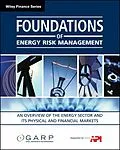GARP's Fundamentals of Energy Risk Management introduces investors to the basic components and some of the basic terminology used in the energy industry. It covers the commodity cycle, energy use and sources, and various risk types, various energy products and the markets where energy is traded. It also introduces certain risk management fundamentals and real option thinking. The book is GARP's required text used by risk professionals looking to obtain their Certificate in Energy Risk Management.
Autorentext
The Global Association of Risk Professionals (GARP) is a not-for-profit association consisting of 74,890 individuals around the world who are involved in financial risk management. Members come from more than 100 countries and work in regional and global banks, asset management firms, insurance companies, central banks, securities regulators, hedge funds, universities, large industrial corporations and multinationals.
Klappentext
A comprehensive overview of the energy sector and its physical and financial markets The first in a series of study guides for GARP's Certificate in Energy Risk Management program
The Global Association of Risk Professionals (GARP) created the Certificate in Energy Risk Management to provide a practical understanding of the risks inherent in the energy industry and to offer a comprehensive overview and analysis based on the everyday practice of energy risk management in the global physical and financial energy markets.
Foundations of Energy Risk Management is an integral part of GARP's Certificate in Energy Risk Management—a rigorous, practice-driven, comprehensive program developed to meet the needs of today's dynamic global energy markets and the highly skilled professionals working with energy—and the first in a series of books focusing on energy risk management.
Developed from in-depth insights and expert advice from internationally recognized leaders in energy risk management, this book familiarizes the reader with the language of the energy industry, energy trading, and risk management, and covers:
- The steps in the commodity cycle
- The global markets for various energy products—crude oil, refined products, natural gas, LNG, and electricity/power
- The various risk types inherent to the energy business
- The risk management tools available to energy companies . . . and much more
Each chapter contains practical, real-life examples and explanations of energy-related events to explain the "science" and "business" of energy. Tables, graphs, and diagrams reveal the complex path energy takes to reach the consumer, the risks relating to various energy commodities, and the role of the commodity markets. For anyone working in the energy industry or interested in energy, it is essential to have a firm understanding of the physical and financial energy markets, how these two markets interrelate, and what risks are involved in each. Foundations of Energy Risk Management helps in achieving this goal.
It puts you in a better position to excel in GARP's Certificate in Energy Risk Management.
Completing the Certificate in Energy Risk Management is not only an accomplishment, but the right step in career development.
Zusammenfassung
GARP's Fundamentals of Energy Risk Management introduces investors to the basic components and some of the basic terminology used in the energy industry. It covers the commodity cycle, energy use and sources, and various risk types, various energy products and the markets where energy is traded. It also introduces certain risk management fundamentals and real option thinking. The book is GARP's required text used by risk professionals looking to obtain their Certificate in Energy Risk Management.
Inhalt
Introduction vii
Garp's Certificate in Energy Risk Management ix
Garp's Foundations of Energy Risk Management Course Specification xi
Syllabus and Learning Outcomes xi
User Guide xii
Chapter 1: The Energy Cycle 1
1.1 Introduction 1
1.2 Exploration 3
1.3 Production or Extraction 4
1.4 Processing 6
1.5 Transportation and Storage 7
1.6 Refining 8
1.7 Distribution 8
1.8 Integrated and Specialty Companies 9
Chapter 2: Risks in the Energy Cycle 13
2.1 Overview 13
2.2 Market Risk 15
2.3 Credit Risk 15
2.4 Operational Risks 16
2.5 Liquidity Risk 19
2.6 Political and Regulatory Risk 20
2.7 Price Risk and Credit Risk 21
2.8 Integrated Vs. Specialty Companies 22
2.9 Common Risk Management Tools 23
2.10 Volatility and Energy Risk Management 24
Chapter 3: World Energy Use 27
3.1 Overview 27
3.2 Energy Intensity 30
3.3 Energy Consumption by End-Use Sector 31
Chapter 4: Major Sources of Energy 33
4.1 Overview 33
4.2 World Crude Oil 35
4.2.1 Production 35
4.2.2 Consumption 36
4.2.3 Oil Reserves 38
4.2.4 Factors Influencing World Oil Markets 40
4.2.5 Factors Influencing Crude Oil Prices 40
4.2.6 Refined Crude Oil Products 42
4.3 World Natural Gas 45
4.3.1 Production 45
4.3.2 Consumption 47
4.3.3 Natural Gas Reserves 47
4.3.4 Factors Affecting Gas Markets 50
4.3.5 Factors Affecting Natural Gas Prices 50
4.4 World LNG 51
4.4.1 Recent Developments 52
4.4.2 The LNG Market 52
4.5 Coal 53
4.5.1 Production 54
4.5.2 Reserves 55
4.5.3 Consumption 56
4.5.4 Coal to Liquid Fuels (CTL) 57
4.6 Power / Electricity 57
4.6.1 Power Generation 58
4.6.2 Basic Technical Fundamentals of Power 64
Chapter 5: The Markets for Energy Products 69
5.1 Introduction 69
5.2 The Physical Markets 70
5.2.1 Spot Markets 70
5.2.2 Crude Oil Spot Markets 71
5.2.3 Crude Oil Forward Markets 71
5.2.4 Physical Gas Markets 72
5.3 The Financial Markets 72
5.3.1 Organization of Financial Markets 73
5.3.2 Financial Derivatives 75
5.3.3 Basis Risk 80
5.3.4 Speculation, Arbitrage and Hedging 81
5.4 The Relationship Between the Physical and Financial Prices 85
5.5 Emission Trading 86
5.5.1 Emission Trading Programs 87
5.5.2 Emission Trading in the United States 87
5.5.3 Emission Trading in the European Union 88
5.5.4 Kyoto Protocol 88
Chapter 6: Real Options in the Energy Market 91
Glossary 95
Index 109
Acknowledgments 119
